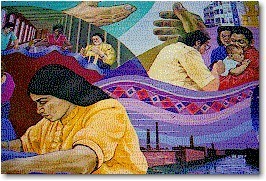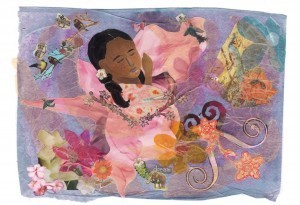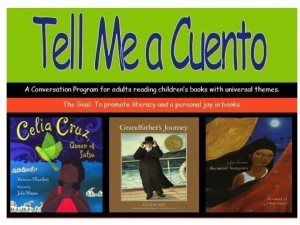Terry Farish's Blog, page 24
May 12, 2014
Finding the Dove – Writing Workshops
 Here are some handouts for teachers. They include ideas for mentor texts for writers and some prompts that have led to collaborative writing or personal writing. You’ll also see a link to TELL ME A CUNETO, a booklet created by adult students in Lawrence, MA. The poems included are written in response to the illustrated books we read together in “Tell Me A Cuneto” workshops. The booklet can also be used as a reading list for books supporting writing and conversation in the classroom, annotated with students’ poems. The dove in the title of this workshop comes from a story by a student named Aqila Sharafyar, “The Faithful Doves of My Father: An Unforgettable Story” published in I REMEMBER WARM RAIN: 15 Teenagers, 15 Coming to America Stories, The Telling Room, Portland, Maine.
Here are some handouts for teachers. They include ideas for mentor texts for writers and some prompts that have led to collaborative writing or personal writing. You’ll also see a link to TELL ME A CUNETO, a booklet created by adult students in Lawrence, MA. The poems included are written in response to the illustrated books we read together in “Tell Me A Cuneto” workshops. The booklet can also be used as a reading list for books supporting writing and conversation in the classroom, annotated with students’ poems. The dove in the title of this workshop comes from a story by a student named Aqila Sharafyar, “The Faithful Doves of My Father: An Unforgettable Story” published in I REMEMBER WARM RAIN: 15 Teenagers, 15 Coming to America Stories, The Telling Room, Portland, Maine.
 Finding the Dove – Writing With ESOL Students. Reading List and Prompts
Finding the Dove – Writing With ESOL Students. Reading List and Prompts
May 1, 2014
Mosaic: Our Characters in the World
 “Mosaic: Our Characters in the World”: A workshop for writers of children’s and young adult books.
“Mosaic: Our Characters in the World”: A workshop for writers of children’s and young adult books.
Maria Padian and I are presenting this workshop at the New England SCBWI conference in May. I’ll add resources on this topic regularly here on my site. Here’s the first post offering the premise of the workshop and some writing prompts to ponder a work in progress.
Mosaic: Placing Characters in the World – Writing Prompts
“We become not a melting pot but a beautiful mosaic,” Jimmy Carter writes of the U.S. “Different people, different beliefs, different yearnings, different hopes, different dreams.” This session is about honoring an intention of authenticity in writing outside our own cultural identity. We might get it wrong in this politically charged terrain of race and class. But begin to imagine. Our focus is on the deep intention of authenticity grounded in the craft of fine writing. Below are some writing prompts to begin to explore writing within the mosaic of cultures.
1. Write down the year your novel is set. Brainstorm three events happening in other cultures of the world that are happening in this year. The events could be happening in the U.S.
2.Write down three threads that run through your novel in progress. Imagine: Can backstory linking a story thread to an outside event in the world serve your story? Could it be a mirror for emotion building in your novel?
3. Write about a keepsake a character saved from a chance encounter (or a chance awareness) with someone of another culture.
4. Make up a journal in which two characters write and/or draw separately about a point of great importance to them. Explore their intimate thoughts. Do they contrast or are there commonalities?
5. Quick free write: describe one character from the point of view of someone outside that character’s culture.
6. List three ways you are different from a character outside your culture. List three ways you are similar to the character.
7. Go on an observation walk in an area you can draw on for details of the novel’s setting. In a notebook, write down clues – scents, objects, shop names, sounds, foods, language, the natural world - to the people who live there.
8. Brainstorm: In your life or in your family or among your best friends you’ve had in your life, brainstorm a connection, a fragment of a story someone told you that relates to a country or a culture not your own.
9. Journal entry exercise: this is borrowed from Kim Stafford who borrowed it from Dorothy Wordsworth, William’s sister. “Every night I would write one sentence about what was happening outside in the world and one sentence about what was happening inside my heart.” Keep a journal for your character, writing an inside and an outside line. Interpret the words inside and outside in any way that serves your story.
10. Write or rewrite one scene of your novel in which a character who is not your main character is of another culture. Just imagine. Does this experiment serve your story in any way?
April 18, 2014
The Alleyway – set in a city of murals

Bread and Roses Mural, Lawrence, MA, by David Fichter
Lawrence, Massachusetts is a city of murals. A “Bread and Roses” mural is on the Lawrence Family Health Center building. Students create murals in the alleyways. Next year, Carolrhoda Books will publish my picture book THE ALLEYWAY set in this city. It’s a story of going away to war from the eyes of a child whose brother is deployed. As the seasons pass through the deployment, the little brother, Luis, paints on the alleyway wall the story of home and the mural grows with his and his brother’s changing lives.

Detail of Lawrence students’ mural painted in 2005. The students wrote, “The city where immigrants become giants.”
Here’s the publisher’s description written by Anna Cavallo at Carolrhoda Books: ”Nico doesn’t have to join the Army to see the world—that’s what younger brother Luis tries to show by painting a mural in the neighborhood alley. But in Nico’s absence, Luis’s world expands along with the mural as family and neighbors add to it. As seasons pass, Luis nervously awaits his brother’s homecoming.”
April 12, 2014
Readers Write Viola’s Next Chapter
Megan, 9th grader, Gorham High in Maine, wrote “College.” She is from Burundi.
Heather Flanders, ELL Specialist at Gorham High School in Maine sent me two stories. She wrote, “I hope you are as moved as I was,” and I was. The stories were written by her students Amna and Megan, their own visions of the next chapter in my novel The Good Braider. Amna is from Kharotum, Megan is from Burundi. In their chapters, they imagine Viola supported by her grandmother’s “power to believe” and as a high school senior on her way to college and willing to take on the hard task of writing essays. Amna and Megan have their own bright futures.
“My Beloveds” by Amna who is from Khartoum
I’ve gotten this far.
Habuba would of been proud of me, if she was with me.
What am I talking about?
She is with me.
I refuse to think she’s dead, but that she’s watching over me like God and the Angels watch over us
Sometimes I talk to her, I hope she can hear my words.
I would of had lots to say to her if she were here.
A year ago, I was in a war, I was living trying to survive, in that war.
And now I live in Portland, Maine where I’m safe
and free.
I knew I would make it this far, and I couldn’t do it without the help of my beloveds.
Andrew, who is now like my prince
My Friends, Abby, Jamal, Poni, and Jakie, who were there for me, when I had trouble fitting in
in this new world
Mrs Mejia who gave me her words of wisdom, she is like no other, with a mind full of knowledge
and a heart made with love.
And to her red nails, I would probably never forget.
My mother, who made this possible
Francis, who gave me love with fun, who is the blood that flows in my heart, always with me until I run out.
Habuba, who gave me hope and the power to believe.
“College” by Megan
Summer vacation is now over.
I’m returning to school as a senior, next year I am going to college.
Mrs. Mejía is talking to me about college applications, it is very
complicated, so I decide to ask Andrew who is now my boyfriend.
Andrew offers to help me with the applications but I’d rather have
Mrs. Mejía help me. This year I have so many essays to write and
it seems like I’m gonna struggle with homework and jobs. I plan
to quit the job for senior year but I still have to talk to my mother.
I don’t think she will approve of my decision, but after the incident
happened, she has been trying to understand me and my decisions.
It is now 2 p.m and I have to go home so I can talk with my mom, but Andrew
offers to drive me home and I can’t say no to those sweet green eyes.
I get home and see a woman in the kitchen, she is covered from head to toe,
and she smells like Juba, I try to see her face and she turns and says,
“oh…hi you scared me Viola!”
“Gwendolyn…..”, I start crying and I can’t believe it, she is standing here,
in my kitchen, in Maine with her little kid. My mom comes in the kitchen and
all my attention turned away from Gwendolyn and towards my mother. Mom looks at me
and says, “what’s wrong?”
“Nothing….can I talk to you in private?”
“ Of course…tell me what’s bothering you?” My mom talks to me like an adult now,
she’s very understanding.
“This year I’m gonna have to write a lot of papers, and you know I struggle with writing….So I was thinking about quitting the job for this school year. what do
you think?” I’m shaking as I say it, I do not know what her reaction is gonna
be like, I’m nervous.
“ Ok. you can do it but as soon as your senior year is over I want you to look for a job.
The only reason I’m doing this is because I want you to have a scholarship.”
“Thank you mother.”
After that conversation, I feel so relieved and go back to the kitchen to talk
to Gwendolyn so she can tell me her journey, I cannot believe my life is so organized and happy
I have finally settled, I’m almost an american but my memory
keeps me a african girl.
Viola’s Next Chapter
Megan, 9th grader, Gorham High in Maine, wrote “College.” She is from Burundi.
Heather Flanders, ELL Specialist at Gorham High School in Maine sent me two stories. She wrote, “I hope you are as moved as I was,” and I was. The stories were written by her students Amna and Megan, their own visions of the next chapter in Viola’s life. Amna is from Kharotum, Megan is from Burundi. In their chapters, they imagine Viola supported by her grandmother’s “power to believe” and as a high school senior on her way to college and willing to take on the hard task of writing essays. Amna and Megan have their own bright futures.
“My Beloveds” by Amna who is from Khartoum
I’ve gotten this far.
Habuba would of been proud of me, if she was with me.
What am I talking about?
She is with me.
I refuse to think she’s dead, but that she’s watching over me like God and the Angels watch over us
Sometimes I talk to her, I hope she can hear my words.
I would of had lots to say to her if she were here.
A year ago, I was in a war, I was living trying to survive, in that war.
And now I live in Portland, Maine where I’m safe
and free.
I knew I would make it this far, and I couldn’t do it without the help of my beloveds.
Andrew, who is now like my prince
My Friends, Abby, Jamal, Poni, and Jakie, who were there for me, when I had trouble fitting in
in this new world
Mrs Mejia who gave me her words of wisdom, she is like no other, with a mind full of knowledge
and a heart made with love.
And to her red nails, I would probably never forget.
My mother, who made this possible
Francis, who gave me love with fun, who is the blood that flows in my heart, always with me until I run out.
Habuba, who gave me hope and the power to believe.
“College” by Megan
Summer vacation is now over.
I’m returning to school as a senior, next year I am going to college.
Mrs. Mejía is talking to me about college applications, it is very
complicated, so I decide to ask Andrew who is now my boyfriend.
Andrew offers to help me with the applications but I’d rather have
Mrs. Mejía help me. This year I have so many essays to write and
it seems like I’m gonna struggle with homework and jobs. I plan
to quit the job for senior year but I still have to talk to my mother.
I don’t think she will approve of my decision, but after the incident
happened, she has been trying to understand me and my decisions.
It is now 2 p.m and I have to go home so I can talk with my mom, but Andrew
offers to drive me home and I can’t say no to those sweet green eyes.
I get home and see a woman in the kitchen, she is covered from head to toe,
and she smells like Juba, I try to see her face and she turns and says,
“oh…hi you scared me Viola!”
“Gwendolyn…..”, I start crying and I can’t believe it, she is standing here,
in my kitchen, in Maine with her little kid. My mom comes in the kitchen and
all my attention turned away from Gwendolyn and towards my mother. Mom looks at me
and says, “what’s wrong?”
“Nothing….can I talk to you in private?”
“ Of course…tell me what’s bothering you?” My mom talks to me like an adult now,
she’s very understanding.
“This year I’m gonna have to write a lot of papers, and you know I struggle with writing….So I was thinking about quitting the job for this school year. what do
you think?” I’m shaking as I say it, I do not know what her reaction is gonna
be like, I’m nervous.
“ Ok. you can do it but as soon as your senior year is over I want you to look for a job.
The only reason I’m doing this is because I want you to have a scholarship.”
“Thank you mother.”
After that conversation, I feel so relieved and go back to the kitchen to talk
to Gwendolyn so she can tell me her journey, I cannot believe my life is so organized and happy
I have finally settled, I’m almost an american but my memory
keeps me a african girl.
March 21, 2014
Wings for a Flower author interview

Cut-paper illustration, Chenai, India street scene, by Ellen Gaffney
Ellen Gaffney’s picture book WINGS FOR A FLOWER tells a story of disability and freedom. I have a friend so close he is like my brother. He has never walked and from the time he was a toddler he got around in a  wheelchair. I had not thought about what a person would do if they couldn’t get a wheel chair which I’ve learned is true for 100 million people around the world. Ellen tells the story of a child in India named Lotus who becomes ill and loses her ability to walk. She does not leave her hut from that point. She had the great fortune of meeting a doctor who brought her a chair with wheels. He lifted Lotus into the chair and told her to put her hands on the wheel. “They did not need to say more,” Ellen Gannfey writes. Gannfey tells the story with spare words and cut paper illustrations, “each element created individually.” I was fascinated by these illustrations. I wrote to ask her to tell the story of this book.
wheelchair. I had not thought about what a person would do if they couldn’t get a wheel chair which I’ve learned is true for 100 million people around the world. Ellen tells the story of a child in India named Lotus who becomes ill and loses her ability to walk. She does not leave her hut from that point. She had the great fortune of meeting a doctor who brought her a chair with wheels. He lifted Lotus into the chair and told her to put her hands on the wheel. “They did not need to say more,” Ellen Gannfey writes. Gannfey tells the story with spare words and cut paper illustrations, “each element created individually.” I was fascinated by these illustrations. I wrote to ask her to tell the story of this book.
1. How did you come to know the story of Lotus that you tell in WINGS FOR A FLOWER? You write that this is the nonfiction story of a true girl, Lotus.
I heard the story of Lotus Blossom directly from the founder of the Free Wheelchair Mission, Don Schoendorfer. Don and his wife Laurie are long-time personal friends of my husband and mine. Don had a career in medical products before deciding about 12 years ago that it was time to address a problem that had troubled him for decades: disabled people crawling on the ground in developing countries. In the late 1970’s Don and his wife had traveled to Morocco where they saw a woman on a city street begging. She was on the ground because she couldn’t walk and she was very poor. They looked around for a hint about what to do: should they try to help her? No one else was doing anything, so they continued on their way, but the troubling image stayed with Don. Decades later, in 2002 he set out to design a very low-cost wheelchair that would be appropriate for the terrain of developing countries and could be given away – free to the recipient. When Don had 4 prototype chairs ready to go, handmade in his garage of a resin lawn chair, mountain bike tires, a sturdy metal frame and some front casters, he invited himself and his chairs to join a medical mission trip to India. Lotus Blossom received one of those chairs. In 2005 Don told me about Lotus. It was a story filled with much emotion: the helplessness of her family when she became ill, the isolation her disability brought, the joy Lotus felt when she got her wheelchair, and her hope and determination. I began writing the story for my book almost as soon as I heard it.
2. Tell us about your artwork. What’s your process to create the illustrations for WINGS FOR A FLOWER? Is there a link between Lotus’ story and your technique in telling the story visually? The illustrations are made of cut/torn paper of all kinds – tissue, craft paper, magazines, catalogues – pretty much anything that evokes “India” for me. In 2005 I spent time with Lotus and her family in their neighborhood in Chennai, India. I knew I wanted to try to convey the intensity of the colors and sounds and smells in my book but I wasn’t sure how I would do that. I took Ilse Plume’s children’s book illustration course at the Museum School in Boston and I used collage for an early assignment. I loved the process of finding papers, handling them, and ‘building’ an image. Most importantly, I felt the medium was really well suited to the story: the patterns and colors from clothing catalogues worked well for the women’s saris, and colored tissue paper was great for enhancing the images in a lot of different ways. And of course, little items like chickens and bananas and pots were fun, realistic things I could include to add depth to the scenes. My first illustrations were trial-and-error: sometimes I’d want to add something in the background after the foreground was already done – oops. That meant laying the background in around the part of the picture that was already done, or starting over… Eventually I developed a technique of drawing the illustration, tracing it onto tracing paper and planning the construction of the image before gluing anything down, which worked much better. Many people really like the ‘dream’ illustration after Lotus gets her chair. It’s less realistic and more loose than most of the other pictures. It was fun creating that dreamy feeling. The big street scene that shows time passing was also a lot of fun, but much more difficult. It’s a two-page spread with daytime, nighttime, rain, and lots of people. Each element was created individually: each person, building, window, tree, vehicle etc. Then the whole scene was assembled like a puzzle, and finally it was all glued down. It took over two weeks working every day.
3. Are there many people like Lotus who can’t walk and have no way to be mobile?
Unfortunately, yes. It’s estimated that about 100 million people are in need of wheelchairs. There are so many dimensions to the problem of being both disabled and very poor it can seem overwhelming: inadequate health care, disease, conflict (wars, landmines), social intolerance and discrimination, and more. The wheelchair can’t address all of them, but it can provide more dignity to that person who can’t walk and ease the burden on his or her family.
The Free Wheelchair Mission’s distribution partners are the front-line workers, identifying people who need wheelchairs, assembling the chairs and giving them away without discrimination. They also educate people in their home countries about disability and advocate for services for and inclusion of disabled members of their communities. What they’re able to accomplish with scarce resources and hugely generous hearts is nothing short of amazing.
February 28, 2014
The Pirate Tree





As a reviewer for The Pirate Tree, Social Justice and Children’s Literature I’ve had my eye out for great books on our topic. Above are some of those that I’ve reviewed at The Pirate Tree. Please check out the site for reviews by me and fellow Pirates. Topics range from children of incarcerated parents to issues around disability to immigration to the environment.
December 6, 2013
Watch South Sudanese rapper’s tribute to The Good Braider
 This amazing musician of South Sudan and Portland, Maine, OD Bonny, wrote this song for The Good Braider. It’s called “A Girl from Juba.” This is a wonderful, authentic interpretation of the book, shot on the streets of Portland. You have to hear.
This amazing musician of South Sudan and Portland, Maine, OD Bonny, wrote this song for The Good Braider. It’s called “A Girl from Juba.” This is a wonderful, authentic interpretation of the book, shot on the streets of Portland. You have to hear.
The Magic of OD

OD
This amazing musician, of South Sudan and Portland, Maine wrote this song for The Good Braider. You have to hear. http://www.youtube.com/watch?v=sxd1sw...
November 22, 2013
Why Verse? Poetic Novels for Historical Fiction, Displacement Stories, and Struggling Readers
click for article: School Library Journal, November, 2013
By Terry Farish on November 18, 2013
from “Why Verse”
As I was writing The Good Braider, and as the story emerged in images told in spare language, I was not thinking of possible readers. I was looking for the key to capture the truth of the story. That way of homing in on a subject was what drew me to the specificity and spareness of poetry. I love what Rita Dove, a former U.S. poet laureate, said about verse novels during an Association of Writers and Writing Programs (AWP) Conference panel titled “Staggered Tellings: Immediacy, Intimacy, and Ellipses in the Verse Novel.” Verse novels, she said, offer “the weight of each word, the weight of the sentence, the weight of the line, the weight of white space, heightened attention to sound, and deep allegiance to silence.”
Please the full article at School Library Journal on line
In a sidebar I offer this reading list:
THE WORLD IN VERSE
Here are some books in verse that tell stories of new arrivals to the U.S. or explore the native countries of some who have left their homes.
Applegate, Katherine, Home of the Brave
(Macmillan, 2007)
Engle, Margarita, The Lightning Dreamer: Cuba’s Greatest Abolitionist (Houghton Harcourt, 2013)
Engle, Margarita, The Surrender Tree: Poems of Cuba’s Struggle for Freedom (Macmillan, 2008)
Farish, Terry, The Good Braider (Amazon, 2012)
Herrera, Juan Felipe, Downtown Boy(Scholastic, 2005)
Lai, Thanhha, Inside Out and Back Again
(HarperCollins, 2011)
McCormick, Patricia, Sold (Hyperion, 2006)
Ostlere, Cathy, Karma (Penguin, 2011)
Testa, Maria, Something About America
(Candlewick, 2005)




